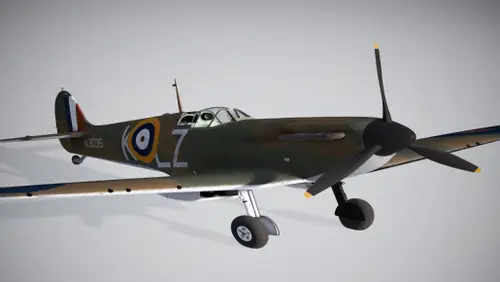The Supermarine Spitfire Mark 1A is a British single-engine, single-seat, multi-role fighter aircraft that saw heavy use by the Royal Air Force during the early part of World War II. Deliveries of the first Mark 1As began in June of 1938, just over two years after its prototype first took to the sky. Notable for its aerial victories above England during the Battle of Britain, the Mark 1A was the first of a series of production iterations of the venerable Spitfire lineage that forged an indelible mark in military and aviation history.
The Spitfire Mark 1A’s most distinctive characteristic, its elliptical wing that has a span of just under 37 feet, provides it with its superior maneuverability and high top speed. Complementing the wing, the aircraft is powered by a liquid cooled, V-12 Rolls-Royce Merlin III engine that produces 1,030 horsepower and drives a de Havilland three-blade, constant-speed propeller.
The Mark 1A has a climb rate of 2,500 feet per minute, a level-flight top speed of 367 miles per hour, and a dive speed of 450 mph. The aircraft boasts a service ceiling of 34,400 feet above sea level and a combat range of 395 miles. Armed with eight wing-mounted .303 Browning machine guns, the Spitfire became renowned for a number of mission types including intercepting enemy aircraft, ground attack, reconnaissance, and even trainer.
Aviators who have flown the Spitfire Mark 1A revere its performance and exalt it as a machine of which the pilot and it become one. Climb into the cockpit and prepare for one of the ultimate adventures of the sky.
The Spitfire Mk. 1a LR is a British single-engine, single-seat, high-performance military aircraft. It is a long-range variant of the first production line of the legendary Spitfire, one of the most renowned fighter aircraft in history. The Spitfire made history during World War II and was the only British fighter manufactured throughout the entirety of the conflict.
One of the key characteristics of the Spitfire family that made it such a successful and operationally enduring airframe is its distinctive elliptical wing. It was created to balance aerodynamic efficacy with the ability to house machine guns and retracted landing gear, and its shape proved to make the Spitfire a great performer at high altitudes.
The prototype of the Spitfire took its maiden flight on May 5, 1936. The first production variant, the Spitfire Mk. 1a, first flew on May 14, 1938 and entered service on August 4 of that year. The Spitfire Mk. 1a participated in a number of key battles, notably the Battle of Britain. During combat, it was armed with eight machine guns (four on each side of the wing) with 350 rounds per gun. The Spitfire Mk. 1a LR is a long-range experimental variant with extra fuel storage to test the efficacy of using the Spitfire to escort long-range strategic bombers.
The Spitfire Mk. 1a LR measures 29 feet, 11 inches in length, stands 11 feet, 5 inches tall, and has a wingspan of 36 feet, 10 inches. It is powered by a liquid-cooled V-12 piston engine that delivers up to 1,030 horsepower and turns a 3-blade propeller. The aircraft has a range of up to 650 miles, a service ceiling of 32,000 feet above sea level, and a climb rate of 1,800 feet per minute. It cruises at 286 miles per hour and has a maximum speed of 330 mph.
The Spitfire Mk. II is a British single-seat, single-engine, World War II-era fighter aircraft. It is the second production iteration of the famed Spitfire aircraft line that took its maiden flight on May 5, 1936 and entered service in 1938. The Spitfire Mk. II is an upgraded variant of the original production version, the Mk. I, with a more powerful engine and a slight modification to its forward right-side cowling to accommodate the new engine’s electric starter. The Spitfire Mk. II was first flown in 1939 and introduced in August of 1940.
The Spitfire line of aircraft is one of the most famous in history. The airframe, in all its iterations, was the only British fighter to be manufactured throughout the entire length of World War II. One of its key distinguishing characteristics is the aircraft’s elliptical wing. The distinctive wing was developed to minimize drag while being able to accommodate machine guns / cannons and retracted landing gear. The wing’s form engenders high performance flight of the Spitfire, especially at high altitudes.
The Spitfire Mk. II was armed with either eight machine guns or four machine guns and two cannons. The Mk. II primarily performed the roles of interceptor and air superiority but was also used for surface attack (ground and maritime), and ISR (intelligence, surveillance, and reconnaissance) data collections.
The Spitfire Mk. II measures 29 feet, 11 inches in length, stands 11 feet, 5 inches tall, and has a wingspan of 36 feet, 10 inches. It is powered by a V-12, liquid-cooled piston engine that delivers up to 1,175 horsepower. The aircraft has a range of up to 575 miles, a service ceiling of 37,000 feet above sea level, and a climb rate of 3,000 feet per minute. It cruises at 311 miles per hour and has a maximum speed of 355 mph.






































